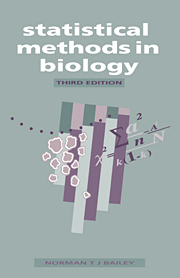Book contents
- Frontmatter
- Contents
- Preface
- 1 Introduction
- 2 Variability and frequency distributions
- 3 Estimation, standard errors and confidence limits
- 4 The basic idea of a significance test
- 5 Simple significance tests based on the normal distribution
- 6 The use of t-tests for small samples
- 7 Contingency tables and χ2
- 8 χ2-tests of goodness-of-fit and homogeneity
- 9 The correlation of measurements
- 10 Regression analysis
- 11 Simple experimental design and the analysis of variance
- 12 Introduction to factorial experiments
- 13 Random samples and random numbers
- 14 Partial correlation and multiple regression
- 15 Non-parametric and distribution-free tests
- 16 Notes on numerical calculation, calculators and computers
- Suggestions for more advanced reading
- Summary of statistical formulae
- Appendix tables
- Index
6 - The use of t-tests for small samples
Published online by Cambridge University Press: 05 June 2012
- Frontmatter
- Contents
- Preface
- 1 Introduction
- 2 Variability and frequency distributions
- 3 Estimation, standard errors and confidence limits
- 4 The basic idea of a significance test
- 5 Simple significance tests based on the normal distribution
- 6 The use of t-tests for small samples
- 7 Contingency tables and χ2
- 8 χ2-tests of goodness-of-fit and homogeneity
- 9 The correlation of measurements
- 10 Regression analysis
- 11 Simple experimental design and the analysis of variance
- 12 Introduction to factorial experiments
- 13 Random samples and random numbers
- 14 Partial correlation and multiple regression
- 15 Non-parametric and distribution-free tests
- 16 Notes on numerical calculation, calculators and computers
- Suggestions for more advanced reading
- Summary of statistical formulae
- Appendix tables
- Index
Summary
THE IMPORTANCE OF SMALL SAMPLES
In Chapter 5 we have seen how to carry out a number of simple significance tests when the underlying distribution was either normal or at least approximately normal. It was, however, usually necessary to assume that samples were large, or alternatively that with small samples (as in the comparison of a few observations with a known standard) some additional information was available about the ideal population, such as accurate indications of its mean and variance. Unfortunately, information of this type is often lacking in practice, and we are faced with basing decisions on small samples of data which must be judged and interpreted largely on their own internal evidence.
Many people feel that small samples are so inherently unreliable that it is best not to draw conclusions from them at all. A little reflection will show that having this attitude will result in being unable to deal with a number of very common difficulties. In the first place, it is often not possible to increase the data to any appreciable extent: the number of animals with some rare disease that are available for experimentation may well be quite small, and we are obliged to make the best of it. Again, environ- mental conditions may be so variable in time and space that we can obtain reasonable homogeneity only within the compass of a comparatively small set-up.
Information
- Type
- Chapter
- Information
- Statistical Methods in Biology , pp. 50 - 60Publisher: Cambridge University PressPrint publication year: 1995
